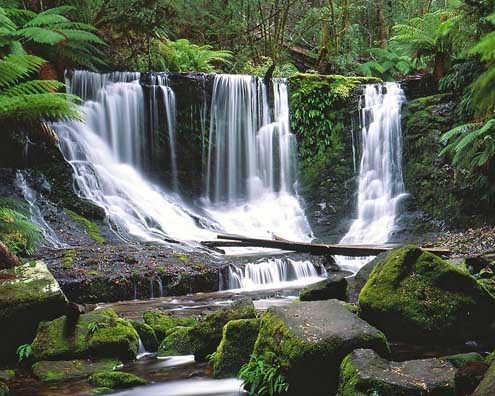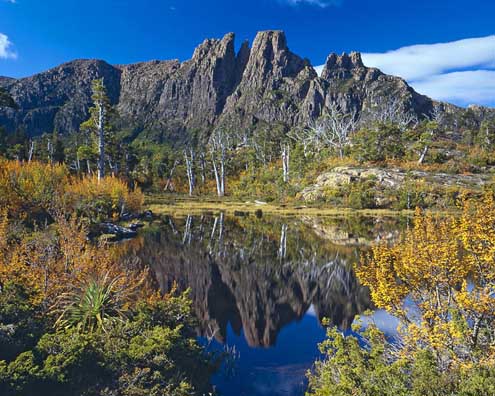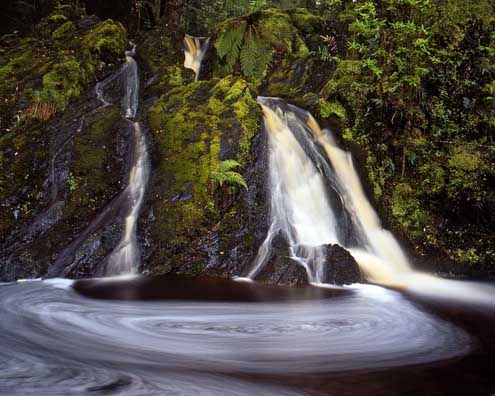
Join our community and recieve updates and information on upcoming interviews. If you have not yet registered, you can register here. Registering is easy and painless. We hope that you join us in the forums for discussions.
This interview took place via e-mail between April 8th and May 10th,2005
This article is Copyright 2005, James Morrissey, and may not, in part or in whole, be reproduced in any electronic or printed medium without prior permission from the author. The images in this article are the property of Geoff Murray and have been licensed to James Morrissey and the NWP Photo Forum for the purpose of this interview.

Horseshoe Falls (c) Geoff Murray - Mamiya 7 80mm lens, 20 sec exposure at f22. A polariser was used.
Mt Field National Park in Southern Tasmania, one of Tassie's most accessible national parks.
Part I: About Geoff Murray
JM: Would you be willing to give us a short social history of yourself? Can you tell us a little about what life was like when you were growing up and what your family is like for you now?
GM: I grew up in a country town in Southern Tasmania called New Norfolk. Only about 10,000 inhabitants at the time. I have one brother, no sisters. Between the ages of 12 to about 18, my father had a part time business as a wedding photographer shooting black and white and colour negs. He processed all his own black and white so I learnt how that process worked although never had a real interest in photography at that stage. He used medium format Rolleicord's then Rolleiflex's. Later on he used Mamiya RB67's then RZ's.
I have a wife, Lyn. We live on a 10 acre bush block with our two Husky-cross dogs 8 km South from New Norfolk. It is a very quiet, peaceful location. www.geoffmurray.com/wildflowers.htm was taken half way along our driveway. We have both been married before and both have two children. I have two boys, aged 20 and 22. Lyn has a boy and a girl, aged the same.
JM: When and how did you first begin to photograph? Who were your artistic influences?
GM: I first began taking photographs properly after separating from my first wife. I had been bushwalking for some time and thought it would be a good idea to buy a reasonable camera. I bought a Nikon f90 and Nikkor 28-70 lens. From that time on, using slide film, things got better and better. Tasmania has a long tradition of exceptionally good landscape photographers. The finest of them all was a man called Peter Dombrovskis who used a Linhof Technica 45 view camera and could create images that were astoundingly good without the use of filters or digital manipulation as so many so called top photographers use these days. Peter died in the mountains of a heart attack several years ago doing what he loved doing most.
JM Where does your photographic education come from?
GM: My photographic education comes from reading good photographic books and practical experience. There has been no formal training.
JM: Are there any books that you feel deserve special note?
GM: A couple of very good books are :
(1) The View Camera by Leslie Stroebel
(2) Large Format Nature Photography by Jack Dykinga
JM: You are a 'part time' photographer - specifically, you are like most of us who have a day job. How are you able to fit photography into your life?
GM: I am fortunate with my main job in that it is entails working in 12 hour shifts - 2 nights and 2 days. I then have 4 days off, so spare time is abundant. I also have holidays twice a year, 5 weeks then 6 weeks, so I am now able to plan trips either within Australia or overseas on a regular basis :-) Someone has to do it !! :-)
JM: How have you developed your portfolio? Your website has a great reputation having received praise for being 'of excellent quality' showing a unique perspective of the island of Tasmania (where you live).
GM: Difficult question. I prefer to take images that are simple but striking. I like strong images that can convey the feel of a location at that time simply and clearly. I have adopted a very strict view of what is worth keeping and what is not, so many images visit the round filing cabinet on the floor in the corner, never to return.
JM: Your home environment, Tasmania, appears to be a spectacular place to live photographically. How has your home environment influenced your work? Have you traveled other places?
GM: Tasmania has exceptionally good scenery, it is not overcrowded and it has a magical quality to the light that allows a reasonable photographer to achieve good images. My wife and I have traveled to the American mid West, Utah, Arizona, Colorado a little of California and New Mexico. It was a fabulous visit with awesome scenery but it was difficult to come up with original images in the time we had there. We were there for 30 days and covered 12,000km by road in that time! I have also visited New Zealand's South Island twice, once withy my wife and again last January by myself. The last trip was a walking trip over about 12 days and 100kms. Unfortunately, it was a very hot period with sunny skies so good images were difficult. The images from the second trip are not yet on the website.
JM: You have told me that when you retire, you hope to be able to photograph full time. Have you thought about how you would be able to realistically make this into a business?
GM: Currently the income from my photography is increasing each year but not yet enough to live off. I have purchased the equipment to allow me to frame my prints and will develop that further over the coming years. When I retire I will use the photography income more as a supplement to maintain a good standard of living so we can continue to travel and enjoy life.
JM: What role does your website play in your business? How are you able to drive customers to your website?
GM: My website is very important for my business. It is easily found and you never know who's going to visit next, be it individual or a large corporation. If someone currently searches for "wilderness photography" in Google it will return my website as #1. Likewise, "landscape photography" puts me on the first Google page at #10. Getting such a good rating is not easy and I'll leave it to the web-masters to find out how it is done :-)
JM: Are you shooting stock photography at all?
GM: I supply 2 small stock libraries. Minimal income comes from them.
JM: How did you first get into stock photography?
GM: I was invited to submit to them by the people that owned them.
JM: How were you able to navigate the various different agencies to find one that was good for you? Do you have any advice for people who are trying to get into stock photography?
GM: I don't feel it is a high income earner, you really do need a large range of images filed to get a reasonable return. Naturally some very successful stock photographers will disagree but it is a long term decision to commit to stock. And in landscape, competition is very strong.
Part II: Technique

Pool of Memories2 (c) Geoff Murray - Horseman 69 view camera, 65mm Schneider Super Angulon Lens, Exposure 1/4 sec at f22. A polariser was used for this image.
Mt Geryon and the Pool of Memories in Autumn. Tasmania only has one deciduous plant, Nothofagus Gunnii or the Deciduous Beech, This is an excellent area fro the Fagus and Tassie's light in Autumn is superb.
JM: Can you describe what it is like being out in the field? What equipment do you bring?
GM: When I am out in the field on an overnight or longer trip I usually end up carrying about 58 to 60 lbs which includes all my bush-walking equipment plus food and camera gear. The camera gear weighs about 23 to 25 lbs. I carry a Horseman 69 view camera, one 69 film back, a Sekonic L608 light meter, 4 lenses (65 SA, 100 and 150 Apo Symmar Schneiders and 300m Nikkor M), a Manfrotto tripod and ball head, a few filters and plenty of Velvia film.
JM: How long do you go for? Who goes with you?
GM: Trips in the field range from a few hours to 10 or so days. Normally 2 or 3 days. Very rarely my wife will come with me (she has learnt to bring a thick book :-) but normally I travel alone. Wilderness photography is a solitary thing.
JM: When shooting on location, what sort of safety precautions do you take if you are out by yourself the entire time?
GM: Common sense and experience. I have walked our bush for quite a few years now and I realise it is important to know your limitations, have the best of gear and watch the weather.
JM: A lot of your work is out on location. How are you able to take the time to find and explore your 'back yard' in this fashion?
GM: I am fortunate that my normal job gives me plenty of spare time to get out and about.
JM: Do you feel comfortable in your coverage of your home area? What do you plan on doing next?
GM: Yes I do, there is always more to discover but I am satisfied I have represented Tassie's wilderness pretty well.
I am looking further afield and currently I have an application in to travel to Antarctica to take photographs under the Australian Antarctic Division's Arts Fellowship program. Later I would like to travel to South America to visit Patagonia and Peru.
JM: What times of day do you like to photograph, and how do you find you work to use light in your photographs?
GM: Photography is all about light and the best light is at dawn and sunset. The rest of the day is usually spent scouting good locations unless it is overcast then there is usable light all day long.
I like images with strong dramatic colours and the best light for that type of photography is at dawn and dusk. I find it is always important to be very patient and wait till well after sunset in particular, sometimes there will be a sudden surprise shaft of light long after it appears to be all over.JM: I see great use of reflection and timed exposures in your pieces. Which other 'tools' do you like to use the most in your work?
GM: I guess the classic wilderness composition is very important i.e. strong foreground emphasised through use of the view camera balanced by a slightly lesser background. Composition is very important, an image has to flow when viewed.
The eye needs to be subtly lead through the image in a relaxed natural manner. Starting at the main subject, generally prominent in the foreground, it will look at the next nearby feature in the image and follow on through each successive feature hopefully with the lesser features visually balancing the main subject.
JM Have you considered dabbling in digital (outside of PS), or do your forsee yourself being a film only guy?
GM: I think an awful lot of people have been sucked in by excellent marketing hype and the promise of extreme convenience. Film is a fantastic medium for storing vast amounts of information in a stable, compact and easily viewed form. The amount of information in a medium format slide is immense, far more than produced by digital cameras or backs. I also think that "digital" is responsible to producing a "machine-gun" mentality. A lot of so-called photographers now seem to adopt the attitude that if they press the shutter release often enough they are sure to get some good shots. Unfortunately it doesn't work like that. When a digital back with a full frame sensor, very high resolution equal to film and minimal power requirement is produced at a sensible price I might consider it. Until then, Fuji Velvia remains king.
JM: How much work do you do in Photoshop, or is this mostly 'straight out of the camera' with minimal processing? The colors in your photographs are absolutely rich with life and vivid. I particularly like your photographs around Cradle NP. They are absolutely mystifying.
GM: Cradle NP is a wonderful place to photograph, as is the Walls of Jerusalem and the Western Arthur Range. Tasmania has very good light and the colours here are rich and dramatic. I use Photoshop to bring the image to as close as possible to the original (providing I exposed correctly for the original). Where the original doesn't have optimal exposure, correction can be done in Photoshop but I am always aware of the trap of punching the colours too much. Many published photographers go a little overboard, I feel, and they lose credibility.
Part III: The Environment

Tarkine Water Falls (c) Geoff Murray - Horseman 69 view camera, 65mm, 40 sec exposure at f22. A polariser was used.
Un-named water fall on Guthrie's Creek in NW Tasmania's Tarkine region. This area has one of the last great stands of cool temperate rainforest and much is being done by conservationists to try to save the area from the threat of mining and logging.
GM Tip "Polarisers are as useful on cloudy overcast days as they are on blue sky days. They bring out the saturated greens perfectly :-)"
JM: Do you consider yourself an environmental activist? If so, why?
GM: I can't, in all honesty, say I am an environmental activist but I do have a deep passion for wilderness and its need for protection and I guess I make my contribution to the cause by portraying its beauty to those who may not see it themselves.
JM: What are the most significant environmental problems facing Tasmania?
GM: Tasmania has huge problems environmentally primarily caused by an out of control forestry industry. Huge areas are already planted with pine and eucalyptus plantations and large swathes of our remaining old growth forests are being clear-felled and wood-chipped. Unfortunately we have a government that has no ecological sympathy and that allows this plundering to go on virtually unchecked. Tasmania's communities are deeply divided as to whether the forestry industry is worthwhile or whether it is a corrupt, bullying, all-devouring monster run by unethical vandals. I personally think it is the latter. I might add that I also work for a paper manufacturer but can say that we do not use any old-growth timber and have very strict environmental policies.
JM: What groups exists to help preserve your natural environment?
GM: There are several groups in Tasmania that are trying to save what we have left. The largest group is The Wilderness Society (http://www.wilderness.org.au/regions/tas/) which is active Australia-wide but originated in Tasmania. Editors Note: The Wilderness Society functions to preserve what is left of the old-growth forests in Tasmania. Tasmania has the tallest hardwood forests on Earth, with trees reaching nearly 100 metres Currently, there are as few as 200,000 Hectares of old growth trees left in Tasmania. 1 Hectare is equivalent to about 2.47 acres.
There is also the Tarkine Coalition (www.tarkine.org) which concentrates on saving our native forests in the Tarkine area in NW Tas and several other smaller groups. Editors Note: The Tarkine Coalition exists to protect the Tarkine Rain forest. The Tarkine Rain forest is Australia's largest tract of Rain forest. Their website has some absolutely grand nature and wildlife photographs.
All of these people are very dedicated to saving our wilderness. Tasmania has also produced some wonderful politicians that stand head and shoulders above the rabble from the other more mainstream parties. These include Bob Brown Christine Milne and Peg Putt. All three have certainly saved much of Tasmania from destruction.
JM: Do you know how much of a roll eco-tourism plays at home?
GM: Eco-tourism is very strong in Tasmania and getting stronger all the time, it's just a pity the government doesn't realise how much more sensible it is than logging!!
Thanks again to Geoff Murray for having sat with me for this interview. If you want to see more of Geoff's work on Tasmania, check out his website at http://www.geoffmurray.com. Feel free to come join us in the NWP Business Forum to discuss any interesting aspects of this interview.
About the front page. Douglas Creek is situated in the middle of the very well-known 65km Cradle Mt - Lake St Clair wilderness walk. One of the huts on the walk is within several hundred metres of this spot. This photograph was taken with a Mamiya 7 Field Camera, 43mm lens, 12 sec Exposure at f22. A polariser was used.